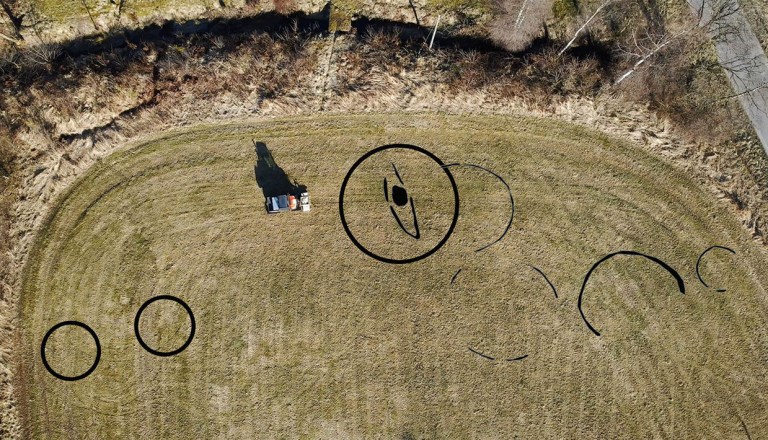Recent research using ground-penetrating radar (GPR) in western Norway uncovered a Viking-era ship that had been buried beneath the ground in Øyesletta, in Kvinesdal.

Along with many weapons, loot, and other artifacts, the ship would have been carrying the remains of an ancient Norse leader. Nearby, the remains of postholes mark the ghostly outlines of two longhouses. The discovery may provide a lot of knowledge regarding ancient shipbuilding techniques as well as Norse burial practices.
This archaeological discovery is of the utmost importance not only because Viking ship burials are extremely uncommon but also because of that Kvinesdal was formerly the location of one of the largest known burial sites from the Iron Age and the Viking Age in all of Southern Norway.
The ancient ship was discovered, according to archaeologists from the Norwegian Institute for Cultural Heritage Research (NIKU), while researchers were conducting geophysical surveys on the site as part of the road-building project E39 led by Nye Veier. The outline of the ship shows up clearly in the radar images, circled by the remains of a ditch that once surrounded a burial mound.
Farmers’ plows demolished the burial mound centuries ago, and the surrounding ditch was eventually filled in with soil. However, the looser soil retains more moisture than the surrounding ground and reflects radar differently. The outcome in radar images is an accidentally perfect logo for Viking Age archaeology: a ship’s hull in a circle. The Gjellestad ship, the largest Norse ship burial ever discovered, stood out in a 2018 radar survey with the same distinctive outline.
Both ends of the ship appear to have been damaged, most likely as a result of a thousand years of plowing. However, the majority of the hull appears to be in good condition. The radar images are detailed enough for archaeologists to recognize the keel (a long wooden timber that forms the backbone of a ship) and the first two planks on either side. The ship was presumably between 8 and 9 meters (26 to 30 feet) long, based on the length of the keel.
When a powerful Viking chieftain died, he was buried on a ship. This involved loading the corpse onto the Viking ship, sailing him out to sea, and then setting fire to the Viking ship. People could watch flames dance high in the air as they embraced the mighty warrior on his way to the afterlife.
By today’s standards, Viking funerals may appear crude, but they were intended to be a spectacular ritual. Viking burial customs included the burning of ships and the performance of complicated ancient rites.
However, this style of burial was probably only reserved for ship captains, noble Vikings, and the exceedingly affluent. Ships in Old Norse times required several months to build and would not have been wasted unless there was a good reason or a sufficient level of prestige.
Another possibility was that the Viking was cremated, as this was a typical practise throughout the early Viking Age. Later, ashes were spread across the seas. Cremations account for the great majority of burials discovered across the Viking world.
Archaeological finds, such as the beautiful Gokstad Viking ship unearthed in1880, provide additional insight into the Viking world. When experts re-opened and inspected the grave in 2007, we were able to learn more about the person who became regarded as one of Norway’s most famous Vikings–the Gokstad Viking Chief and his remarkable battleship.
The Gokstad ship was built in850, during the Viking era’s peak. In those days, there was a demand for ships that could serve a variety of purposes, and the Gokstad ship was versatile enough to be utilized for a variety of voyages, including Viking raids, exploration, and trading.
The ship could be navigated by sail as well as by rowing. Each side of the ship has 16 oar holes available for use. 34 people were needed for the entire crew, which included the oarsmen, steersman, and lookout.
There have been exciting reports of Viking Age burial ships being uncovered in Sweden and Norway in recent years. The discovery of the massive Gjellestad Viking ship burial in Norway a few years ago provided a unique opportunity to experience the world through the eyes of the Vikings.
Archaeologists from the Norwegian Institute for Cultural Heritage Research (NIKU) made the discovery using technology created by the Ludwig Boltzmann Institute for Archaeological Prospection and Virtual Archaeology (LBI ArchPro). Later, scientists used cutting-edge technology to create an incredible virtual tour of the Gjellestad Viking ship burial site, allowing spectators to experience what it looked like in the past.
The recent radar discovery in Øyesletta is encouraging, and researchers are hopeful that they will be able to dig and analyze the Viking ship’s relics. Once they accomplish this, we will learn more about the boat and its history. There is a possibility that the remains of a Viking Chief will also be discovered.




